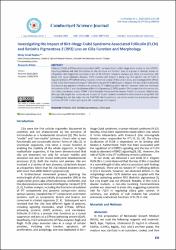Investigating the Impact of Birt–Hogg–Dubé Syndrome Associated Folliculin (FLCN) and Retinitis Pigmentosa 2 (RP2) Loss on Cilia Function and Morphology
Abstract
Folliculin (FLCN), a GTPase-activating protein (GAP), has been linked to Birt–Hogg–Dubé syndrome, the mTORC1 signaling pathway and cilia. Disruptions in cilia structure and function lead to a group of diseases known as ciliopathies. Birt-Hogg-Dubé syndrome is one of 35 different ciliopathy diseases and there are more than 250 genes that cause ciliopathy diseases. FLCN interacts with kinesin-2 along cilia. The specific role of FLCN in regulating Kinesin-IFT trafficking has, however, remained unclear. In the current study, we investigated the effects of flcn-1 loss (the human ortholog of FLCN) on kinesin and IFT trafficking in C. elegans. The loss of flcn-1 alone did not result in any apparent alterations to kinesin or IFT trafficking within the cilia. However, when we combined the deletion of flcn-1 with the deletion of Retinitis Pigmentosa 2 (RP2), another GAP protein, the ciliary entry of a non-ciliary membrane protein TRAM-1 (Translocation Associated Membrane Protein 1) occured. Additionally, although cilia length was unaltered, our analysis of double mutants revealed the extra branch in wing AWB cilia morphology but not the single rod-like PHA/PHB cilia. In summary, our study reveals the previously unknown functions of FLCN in ciliary gating and cilia morphology in C. elegans


















